|
Urinary System
Navigation links
Introduction
After the body oxidizes
nutrient substances, it must deal with excretion (the elimination
of metabolic waste products) to prevent their accumulation and potential
poisoning. The kidneys are essential to the body's excretory needs.
They constantly filter the blood, and selectively reabsorb vital
constituents for conservation. Concentrated waste products and some
remaining water form urine. The kidneys are also key to the homeostatic
regulation of blood volume and pressure, ion concentration, pH,
and red blood cell production.

Back to top
Kidneys:
location and structure
The kidney is a reddish
bean-shaped organ in the lower back near the twelfth rib. It sits
within perirenal fat and renal fascia (connective tissue) that protect
against injury. The lighter-colored outer part of the kidney is
the renal cortex. The darker inner part is the renal medulla. Blood
is filtered in the renal cortex and medulla to form urine.
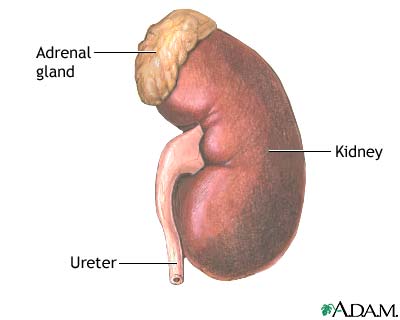
Within the kidney,
urine travels through many structures before it reaches the ureter.
The renal medulla contains dark triangular areas of tissue called
the renal pyramids. Urine flows through a renal pyramid and exits
at the renal papilla, the tip. The renal papilla has collecting
ducts, small openings that allow urine to pass through. From the
collecting ducts, the urine progresses to the renal pelvis, a widened
area of the kidney, and exits through the ureter. The urine passes
through the ureters to the urinary bladder. When the urinary bladder
is full, the body releases urine through the urethra during urination,
or micturition.
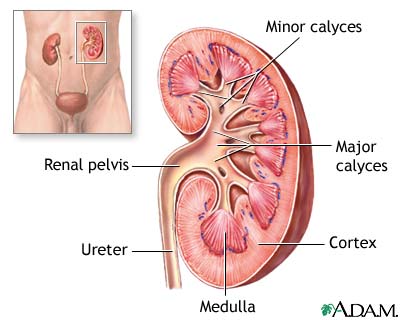
Back to top
Kidneys:
function
The functional unit
of the kidney is the nephron. It contains a glomerular (Bowman's)
capsule, a cup-shaped structure that surrounds a glomerulus (group
of capillaries). Together, the glomerular capsule and glomerulus
form a unit called the renal corpuscle. Attached to the Bowman's
capsule is a long, twisting renal tubule that has four parts: the
proximal convoluted tubule, the loop of Henle, the distal convoluted
tubule, and a collecting duct.
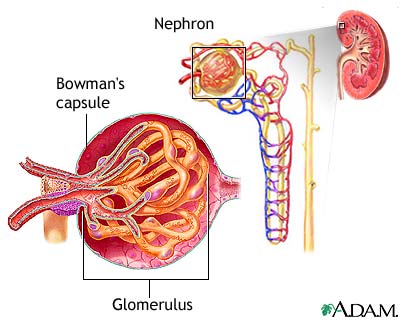
Filtration of the
blood occurs in the renal corpuscle between the Bowman's capsule and glomerulus.
In this nonselective process, fluid and tiny particles in the glomerulus
pass from the blood into the Bowman's capsule and renal tubules. The liquid
substance within the renal tubules is filtrate.
Blood reaches the
kidney through the renal arteries, a branch of the aorta. The path
from the renal artery to the glomerulus runs as follows: lobar artery,
interlobar artery, arcuate artery, interlobular artery, and afferent
arterioles. "Afferent" means that the arteriole is carrying blood
toward the glomerulus.
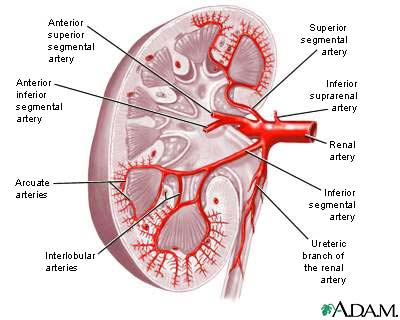
Small openings called
fenestrations fill the capillaries that make up the glomerulus. Fenestrations
allow tiny particles and water to pass into the filtrate. Surrounding
the glomerulus are cells called podocytes. The interlocking pedicels (foot
processes) of these cells surround the capillaries to form the filtration
barrier. This barrier prevents the passage of blood cells, platelets,
and protein molecules into the filtrate. Seven types of matter are small
enough to pass through the filtration barrier: blood plasma (the liquid
part of blood), glucose, amino acids, potassium, sodium, chloride, and
urea (nitrogenous waste).
Some materials in
filtrate are needed to maintain homeostasis (a stable internal environment);
the reabsorption process returns these materials to the bloodstream. Reabsorption
begins after blood leaves the glomerulus through the efferent arteriole.
"Efferent" means that the arteriole is carrying blood away from the glomerulus.
The efferent arteriole forms a peritubular capillary bed that envelops
the renal tubule. As the peritubular capillaries pass near the renal tubule,
useful substances in the filtrate such as glucose, vitamins, amino acids,
water, and ions are reabsorbed into the bloodstream. Back to top
Urine
production
Urine, the fluid that
enters the collecting duct, passes to the urinary bladder through
the ureters. Antidiuretic hormone (ADH) and aldosterone control
how much urine the body produces. If the body becomes dehydrated,
the pituitary gland releases ADH. This hormone reduces urine volume
by causing the collecting tubules to allow more water to be reabsorbed
into the bloodstream. If too much fluid is in the body, the pituitary
gland stops releasing ADH and the excess water passes out of the
body as dilute urine.
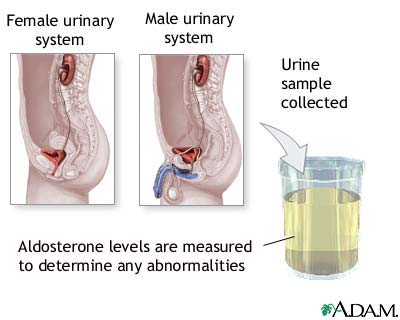
Aldosterone enhances
sodium reabsorption, which increases water reabsorption into the blood
from the collecting tubules. Because of the effect of aldosterone on the
collecting tubules, the amount of water excreted in the urine decreases
and blood volume and blood pressure increase.
Endocrine cells in
the kidneys produce the hormone erythropoietin, which controls erythrocyte
production. Back to top
|